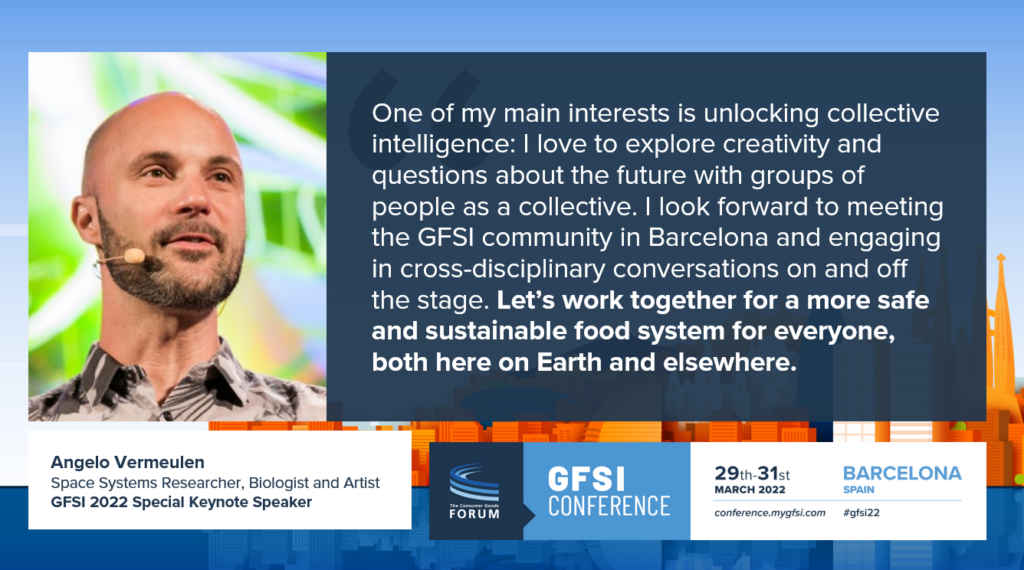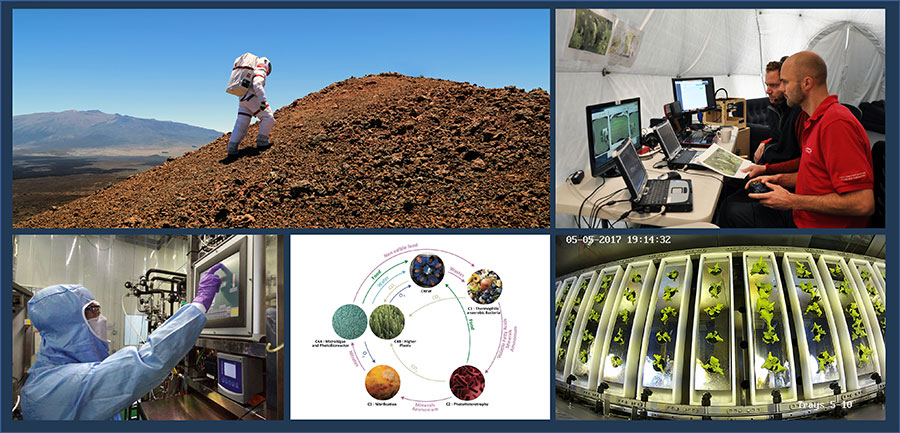Transdisciplinary scientist and artist Angelo Vermeulen shares a preview of his GFSI 2022 keynote
In 2013, I was crew commander of a Mars mission simulation on the high slopes of Hawaii’s Mauna Loa volcano — the first mission under NASA’s Hawaii Space Exploration Analog and Simulation project, or HI-SEAS. Five other people and I lived in a geodesic habitation dome about 11 metres in diameter for four months in isolation, eating mostly freeze-dried and shelf-stable food (including a few treats like Nutella). The purpose of the mission was to model the effects of isolation and limited diet on future Mars explorers. I came away with a few key takeaways. First, astronaut provisions should have plenty of spice and a healthy amount of fibre; and second, food culture is deeply human.
During those four months at HI-SEAS, the crew’s favourite moments in the day often involved preparing and eating meals together. I learned that no matter how much we advance technologically or how far we penetrate outer space, we will always crave the rituals of food. Technically, we could look at humans as processing machines that need a daily number of molecules to sustain them; and that’s the idea that they had in the beginning of the Space Race in the sixties, where the astronauts were eating out of tubes. But even if you select the most hardy, capable people to go to space, they still want a table, they still want a meal routine and they still want good food to enjoy. I find that beautiful: the opposition of the future of humanity and the ancient aspect of gathering around the fire, sharing food and being together.
I will highlight this juxtaposition in my upcoming talk at the GFSI Conference in Barcelona, when I have the honour of closing out three days of conversation around safe food with a special keynote. During the talk, I’ll share stories and photos from HI-SEAS, as well as some details from my work with the European Space Agency. ESA is developing a project called the Micro-Ecological Life Support System Alternative, or MELiSSA: a regenerative ecosystem that uses microorganisms to recycle the waste generated by humans on space missions into oxygen, water and food. Thirty organisations around Europe are involved in MELiSSA, and first the pilot plant is located not far from this year’s conference venue at the Universitat Autònoma de Barcelona. (For safety reasons, the “crew” at the pilot plant is composed of rats, but a human-rated facility is planned for the future.)
Though the MELiSSA initiative is aimed at space, we can all learn from it here on Earth, especially as we think of ways to protect the planet and its people in the face of climate change. MELiSSA proposes a new level of sustainability — molecular sustainability, in which every molecule has the potential to be broken down and reused. The concept of molecular sustainability may inspire the public and private sectors as they collaborate to develop circular economies that maintain food safety and quality. Though I spend much of my time working with space-based initiatives, I’m always building the bridge back to our own planet.
Earthbound food industry professionals can also inspire those building our future in space. For my 2018 project Mission to Mars, I explored the potential of connecting the horticulture industry of the Netherlands — one of the most technologically advanced in the world — with space exploration. We are quickly evolving towards a future in which many people live in space, and we will need to grow calories to feed them. As part of this project, I brought together stakeholders from different sectors and set up a program of lectures around space horticulture. I quickly discovered that this topic, like those discussed at the GFSI Conference, is a two-way conversation. It’s not just that sectors on Earth can learn from those working in outer space; the other direction is equally important. Human civilization is going into space, and we can use the tradition that is already existing on Earth to bring people there.
I hope delegates will come away from my talk invigorated by the concepts of molecular sustainability or space horticulture and inspired by visions of a future in space. Most of all, I would like to challenge the audience to collaborate more across sectors and disciplines. This philosophy underpins all of my work, from HI-SEAS to my work with the SEADS Collective (Space Ecologies Art and Design), a transdisciplinary collective that I co-founded in 2009. One of my main interests is unlocking collective intelligence. To reimagine the future, it’s crucial that we involve multiple disciplines, multiple types of people and multiple cultures. I understand that a similar philosophy forms the foundation of GFSI.
I look forward to meeting the GFSI community in Barcelona and engaging in cross-disciplinary conversations on and off the stage. Let’s work together for a more safe and sustainable food system for all people, both here on Earth and beyond.
Useful links:
- TED Talk: How to go to space, without having to go to space
- Website: Angelo Vermeulen

